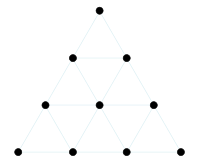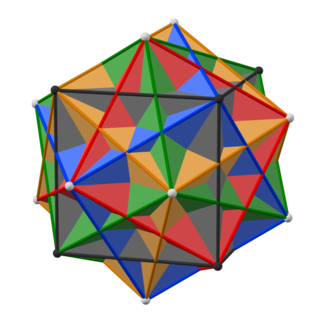Mathematics
Ten is the fifth composite number, and the smallest noncototient, which is a number that cannot be expressed as the difference between any integer and the total number of coprimes below it. [1] Ten is the eighth Perrin number, preceded by 5, 5, and 7. [2]
As important sums,
- , the sum of the squares of the first two odd numbers [3]
- , the sum of the first four positive integers, equivalently the fourth triangle number [4]
- , the smallest number that can be written as the sum of two prime numbers in two different ways [5] [6]
- , the sum of the first three prime numbers, and the smallest semiprime that is the sum of all the distinct prime numbers from its lower factor through its higher factor [7]
The factorial of ten is equal to the product of the factorials of the first four odd numbers as well: , [8] and 10 is the only number whose sum and difference of its prime divisors yield prime numbers and .
- 10 is also the first number whose fourth power (10,000) can be written as a sum of two squares in two different ways, and
Ten has an aliquot sum of 8, and is the first discrete semiprime to be in deficit, as with all subsequent discrete semiprimes. [9] It is the second composite in the aliquot sequence for ten (10, 8, 7, 1, 0) that is rooted in the prime 7-aliquot tree. [10]
According to conjecture, ten is the average sum of the proper divisors of the natural numbers if the size of the numbers approaches infinity, [11] and it is the smallest number whose status as a possible friendly number is unknown. [12]
- The smallest integer with exactly ten divisors is 48, while the least integer with exactly eleven divisors is 1024, which sets a new record. [13] [lower-alpha 1]
Figurate numbers that represent regular ten-sided polygons are called decagonal and centered decagonal numbers. [14] On the other hand, 10 is the first non-trivial centered triangular number [15] and tetrahedral number. [16] [lower-alpha 2]
- While 55 is the tenth triangular number, it is also the tenth Fibonacci number, and the largest such number to also be a triangular number. [19] [lower-alpha 3]
A magic square has a magic constant of 505 , [23] [lower-alpha 4] where this is the ninth number to have a reduced totient of 100; [26] the previous such number is 500, which represents the number of planar partitions of ten. [27] [lower-alpha 5]
10 is the fourth telephone number, and the number of Young tableaux with four cells. [33] it is also the number of -queens problem solutions for . [34]
There are precisely ten small Pisot numbers that do not exceed the golden ratio. [35]
Geometry
Decagon
As a constructible polygon with a compass and straight-edge, the regular decagon has an internal angle of degrees and a central angle of degrees. All regular -sided polygons with up to ten sides are able to tile a plane-vertex alongside other regular polygons alone; the first regular polygon unable to do so is the eleven-sided hendecagon. [36] [lower-alpha 6] While the regular decagon cannot tile alongside other regular figures, ten of the eleven regular and semiregular tilings of the plane are Wythoffian (the elongated triangular tiling is the only exception); [37] however, the plane can be covered using overlapping decagons, and is equivalent to the Penrose P2 tiling when it is decomposed into kites and rhombi that are proportioned in golden ratio. [38] The regular decagon is also the Petrie polygon of the regular dodecahedron and icosahedron, and it is the largest face that an Archimedean solid can contain, as with the truncated dodecahedron and icosidodecahedron. [lower-alpha 7]
There are ten regular star polychora in the fourth dimension, all of which have orthographic projections in the Coxeter plane that contain various decagrammic symmetries, which include compound forms of the regular decagram. [39]
Higher-dimensional spaces
is a multiply transitive permutation group on ten points. It is an almost simple group, of order,
It functions as a point stabilizer of degree 11 inside the smallest sporadic simple group , a group with an irreducible faithful complex representation in ten dimensions, and an order equal to that is one less than the one-thousandth prime number, 7919.
is an infinite-dimensional Kac–Moody algebra which has the even Lorentzian unimodular lattice II9,1 of dimension 10 as its root lattice. It is the first Lie algebra with a negative Cartan matrix determinant, of −1.
There are precisely ten affine Coxeter groups that admit a formal description of reflections across dimensions in Euclidean space. These contain infinite facets whose quotient group of their normal abelian subgroups is finite. They include the one-dimensional Coxeter group [∞], which represents the apeirogonal tiling, as well as the five affine Coxeter groups , , , , and that are associated with the five exceptional Lie algebras. They also include the four general affine Coxeter groups , , , and that are associated with simplex, cubic and demihypercubic honeycombs, or tessellations. Regarding Coxeter groups in hyperbolic space, there are infinitely many such groups; however, ten is the highest rank for paracompact hyperbolic solutions, with a representation in nine dimensions. There also exist hyperbolic Lorentzian cocompact groups where removing any permutation of two nodes in its Coxeter–Dynkin diagram leaves a finite or Euclidean graph. The tenth dimension is the highest dimensional representation for such solutions, which share a root symmetry in eleven dimensions. These are of particular interest in M-theory of string theory.



































